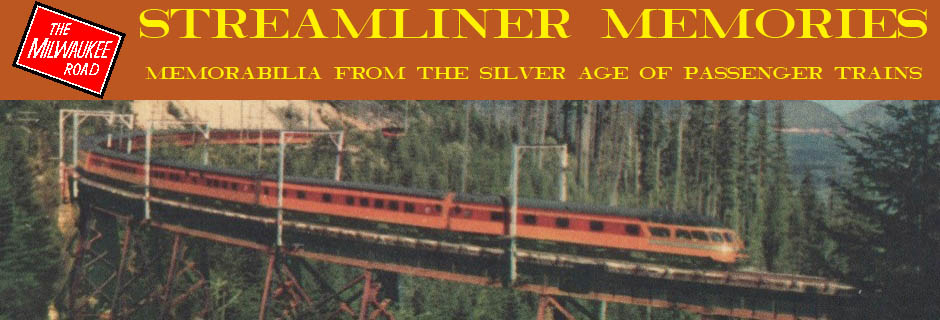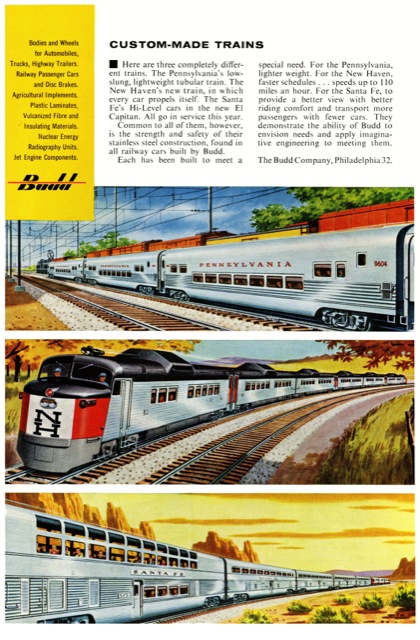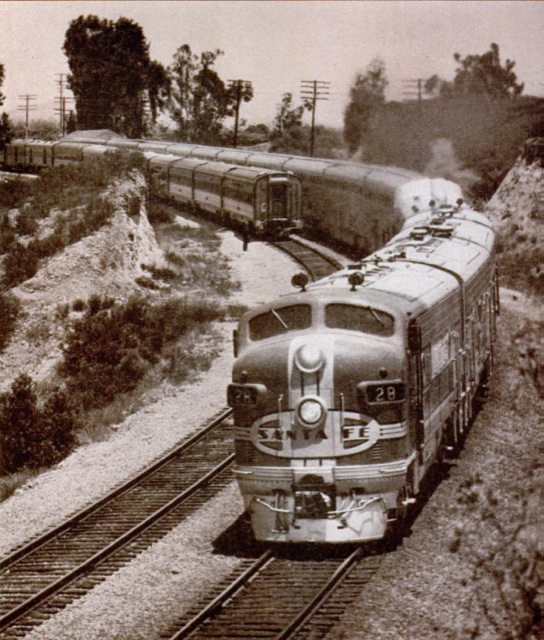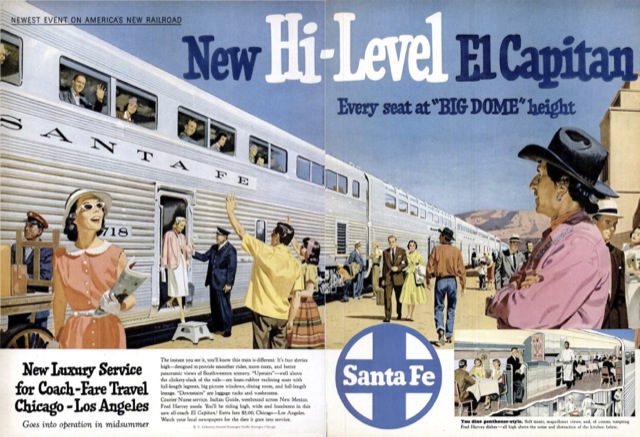There is an intriguing pattern in the seven trains introduced in 1956. Four were outright failures, being pulled from service after less than two years and, at best, run as lowly commuter trains. One, the Santa Fe hi-level, was a great success in the sense that it led to repeat orders from Santa Fe and eventually inspired the Amtrak Superliners. Two more were partial successes in that they continued to serve for at least a decade after their 1956 introduction.
This advertisement features Budd’s three entries into the 1956 “new trains” competition, all of which were successful relative to the Pullman, ACF, and General Motors entries. Click image for a much larger (4.3-MB) view.
All of the failures were articulated; the successes were not. The failures used two-wheel trucks, and approached just one axle per car; the successes used two four-wheel trucks per car. Most notably, all three successful trains were built by Budd.
An article in Popular Science (below) explains why the hi-level cars were such a success even though they bucked the trend of fewer axles, lower centers of gravity, and lighter overall weight. Each hi-level car held more passengers than an ordinary car, so the weight per passenger was lower. Though the super-lightweight trains achieved even lower weights per passenger, they did so by squeezing in more seats (meaning less legroom) and not including diners or lounges. As a Santa Fe official told the Popular Science reporter, “If one of those track-skimming lightweight cars on a Talgo or a Train X were fitted out with comparably wide-spaced seats, it would weigh only seven pounds less, per passenger, than an El Capitan coach.”
Click image to download a 2.3-MB PDF of this five-page article from Popular Science.
Also in 1956, Budd introduced a car it called the Pioneer III, which weighed less than half as much as an ordinary coach. The company claimed a cost of $600 per seat, which was even less than the $1,000-per-seat cost of the Aerotrain. The company received no orders for Pioneer III cars, but the car became the basis of dozens of Silverliner electric cars purchased by the Pennsylvania Railroad for commuter service in Philadelphia.
Was Budd just being cheap when it failed to come up with designs that relied on just two wheels per car and instead merely modified its existing RDC and other coaches? Or did it know something that ACF and Pullman didn’t understand when they invested in the Talgo and Train X designs?
In the nineteenth century, locomotives with four drivers and a four-wheel leading truck became so popular in the United States that they were known as the “American” type of locomotive. One reason why the four-wheel leading truck were so common in the U.S. while most European locomotives had just two-wheel pony trucks is that American rail lines were not built to as high standards as the European ones. The four-wheel truck compensated for the lower quality of the rails.
This two-page spread appeared in the June 11, 1956 Life and June 16, 1956 Saturday Evening Post. Click image to download a PDF of this ad.
Perhaps this remained true even in the 20th century. Though continuous welded rail was first used in the United States in 1930, the mighty New York Central still had jointed rails on its main line between Cleveland and Cincinnati in the late 1950s, contributing to the failure of the Xplorer. Perhaps the Spanish did better with Talgo trains only because their tracks were in better shape. Or perhaps Spanish intercity roads were so awful that even a bumpy train ride seemed preferable.
In any case, Budd emerged the winner in the 1956 effort to revolutionize passenger trains. Though it never eclipsed Pullman as the leading passenger car builder, Budd had a reputation for innovation that made it a passenger favorite from the first Zephyr in 1933 at least through the 1980s.




I wonder if the Talgo was successful in Spain because if the Generalissimo said it was comfortable, it was comfortable!
I suspect it was more of a case of Americans having higher expectations and more alternatives. Europe is/was about 20 years behind the U.S. in auto ownership and rail travel. Remember that Spain built Europe’s most extensive high-speed rail system in recent years and it pretty much failed–they had to close one line completely because it was only getting a handful of passengers each day. While the rest of the lines are operating, the deficits are contributing to Spain being one of the four weakest economies in Europe.